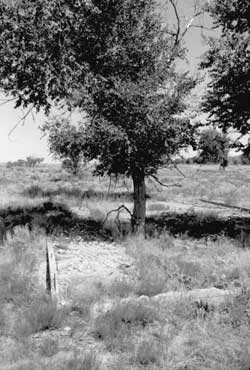MENU
|
| |
Confinement and Ethnicity: An Overview of World War II Japanese American Relocation Sites by J. Burton, M. Farrell, F. Lord, and R. Lord |

|
|
| |
Chapter 5 (continued)
Granada Relocation Center
Security Features
 Figure 5.60. Foundation remains in the military police compound at Granada. |
The foundation blocks of all of six perimeter watch towers are intact (Figures 5.57 and 5.58). Each consists of four square blocks of poured concrete forming a square about 8 feet on a side; each block has metal straps to attach a support post for the tower. In the center of the square is a fifth piece of poured concrete, oblong instead of square, with straps to attach a ladder.
Much of the existing perimeter barbed wire fence around the central area is likely original, although it may have been repaired over the years. The original entrance gate area has been blocked off (Figure 5.59), and the current entrance to the site is via "E" Street, which provides access to the town dump. The fence that separated the evacuee residence area from the administration area has been removed.
In the military police compound, all of the foundations for the buildings marked on the WRA blueprints are still present, although some have been damaged by trees (Figure 5.60). The interior roads and driveways in the compound are discernible but overgrown with vegetation.
 Top
Top
Last Modified: Fri, Sep 1 2000 07:08:48 pm PDT
http://www.cr.nps.gov/history/online_books/anthropology74/ce5h.htm
![]()


